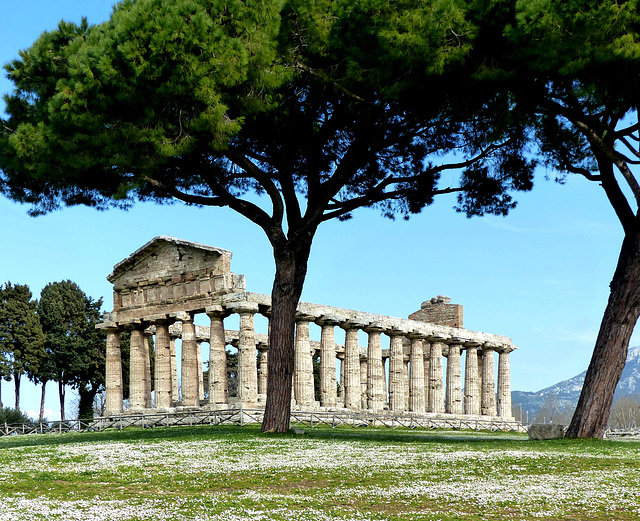Location
Lat, Lng: 40.424568, 15.005438
You can copy the above to your favourite mapping app.
Address: Temple Of Athena
You can copy the above to your favourite mapping app.
Address: Temple Of Athena
Keywords
Authorizations, license
-
Visible by: Everyone -
All rights reserved
-
93 visits
Paestum - Temple of Athena


The city was founded under the name of Poseidonia around 600 BC. founded by Greeks and was part of "Magna Graecia". The extensive trade led to prosperity which spread in the 5th and 6th centuries BC. expressed in the construction of large temples.
Around 270 BC the city became a Latin colonia under the name of Paestum. During the Roman Empire, Paestum lost prosperity and importance. Around 500 AD the area began to silt up and become swampy, malaria spread, and the last inhabitants left the place. The temple complex turned into a kind of jungle, and the place was forgotten. After being destroyed by the Saracens and by the Normans, Paestum was abandoned. An early map showed the ruins in 1732. The rediscovery happened parallel to Pompeii and Herculaneum. An expedition into the enchanted swamp landscape was soon part of the program for the so-called Grand Tour.
The ancient city was surrounded by defensive walls. The area is clear of modern buildings and has been largely so, since the Middle Ages. Although much stone has been stripped from the site, large numbers of buildings remain detectable by their footings or the lower parts of their walls.
The three large Greek temples are the best preserved.
The Temple of Athena (ca 500 BC.). The temple may have been used as a Christian church, as three Christian graves have been found inside.
Around 270 BC the city became a Latin colonia under the name of Paestum. During the Roman Empire, Paestum lost prosperity and importance. Around 500 AD the area began to silt up and become swampy, malaria spread, and the last inhabitants left the place. The temple complex turned into a kind of jungle, and the place was forgotten. After being destroyed by the Saracens and by the Normans, Paestum was abandoned. An early map showed the ruins in 1732. The rediscovery happened parallel to Pompeii and Herculaneum. An expedition into the enchanted swamp landscape was soon part of the program for the so-called Grand Tour.
The ancient city was surrounded by defensive walls. The area is clear of modern buildings and has been largely so, since the Middle Ages. Although much stone has been stripped from the site, large numbers of buildings remain detectable by their footings or the lower parts of their walls.
The three large Greek temples are the best preserved.
The Temple of Athena (ca 500 BC.). The temple may have been used as a Christian church, as three Christian graves have been found inside.
Nouchetdu38 has particularly liked this photo
- Keyboard shortcuts:
Jump to top
RSS feed- Latest comments - Subscribe to the comment feeds of this photo
- ipernity © 2007-2025
- Help & Contact
|
Club news
|
About ipernity
|
History |
ipernity Club & Prices |
Guide of good conduct
Donate | Group guidelines | Privacy policy | Terms of use | Statutes | In memoria -
Facebook
Twitter











Sign-in to write a comment.